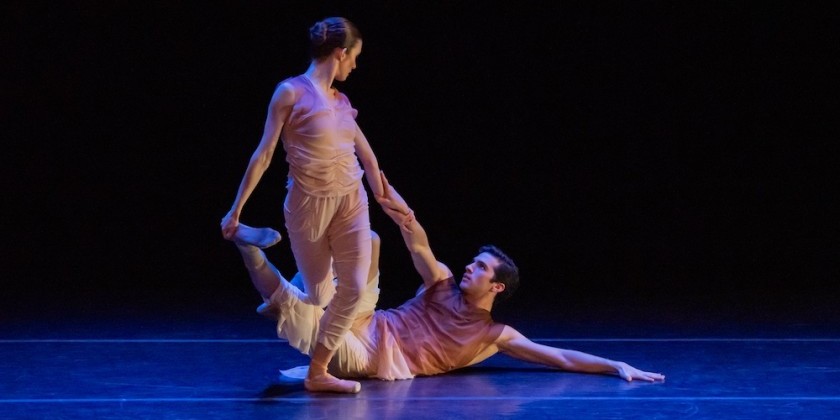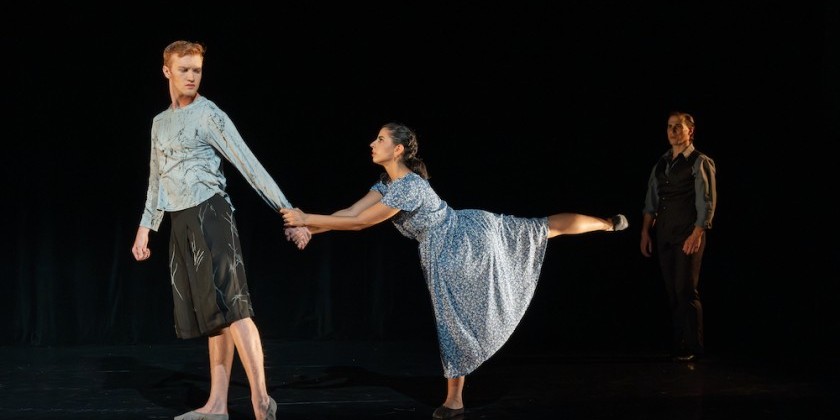Impressions of New York Theatre Ballet's "Legends and Visionaries"

At New York Live Arts
Chemical Bond / Choreography by Milissa Payne Bradley / Music by Gabriel Fauré
Such Longing / Choreography by Richard Alston / Music by Frédéric Chopin
Antique Epigraphs / Choreography by Jerome Robbins / Music by Claude Debussy
Song Before Spring / Choreography by Zhong-Jing Fang and Steven Melendez / Music by Philip Glass
Dance Performances by New York Theatre Ballet
Music Performances by Amy Kang, Zheng Ma, Michael Scales, and NYU Steel
Pictured above: Michael Scales (piano), Amy Kang (cello), Joshua Andino-Nieto, Mayu Oguri
Music exerts an almost magical pull. It makes you think; it makes you feel. Often, it makes you move. In dance, music’s allure is particularly pronounced. Flesh meets sound, and the results can be captivating — for performer and for witness.
In New York Theatre Ballet’s Legends & Visionaries program at New York Live Arts, a quartet of pieces exposes this union between movement and music. Live music, a rare treat, adds a sonic sheen to the intimacy fostered by formidable dancing and performative restraint.
Ballet can have a reputation for exalting its history, rehashing the same rarefied works over and over. Yet, to move forward, the past must be excavated and examined. To this end, Diana Byer, Artistic Director of New York Theatre Ballet, has assembled a collection of pieces that compels the past and the future to meet in the present. The legends are Jerome Robbins and Richard Alston (better known across the pond), the visionaries San Francisco-based Milissa Payne Bradley and the team of Steven Melendez (principal at New York Theatre Ballet) and Zhong-Jing Fang (corps member at American Ballet Theatre).

Classicism acts as the fertile soil within which these choreographers nurture their creativity. Bradley’s brief Chemical Bond, a trio for two women and one man, amplifies the edges and corners of balletic academicism. Against a lush score of Debussy, eight long-legged beauties affect the postures of Greek statues in Robbins’ Antique Epigraphs. During Richard Alston’s Such Longing, two men and two women skim across the floor with folk-infused jumps, a paean to Chopin’s yearning for his native Poland as he lived in his adopted home of Paris.
The biggest bang comes from Steven Melendez and Zhong-Jing Fang’s Song Before Spring. To terrific drumming by NYU Steel, the cast of eight strides through Philip Glass’ persistent, insistent Piano Etudes, Nos 1-10. From day to night, from office workers to party people, this octet evokes the physical busyness and emotional barrenness of an urban landscape. Thrashing twitches of a leg or an arm fizzle out, desire seemingly thwarted by duty. Even the large sweeping movements — cabrioles and jazzy pirouettes — fade rather than resolve.
Gestures of kindness interrupt the Orwellian drama: a hug, a caress, the solicitous placing of a jacket on a quivering individual. Dancers hang at the stage’s edge as various soloists grapple with angst (Elena Zahlmann in a crumpled kneel, Melendez clutching his head). The work opens with the dancers dispersed across the stage, backs to the audience. At the end, they stalk toward us in a clump, the many now united into the one by an accumulation of warm moments.

Song Before Spring succeeds where many contemporary ballet pieces struggle — to fuse the rigorous vocabulary of ballet with other dance forms. Here, the centuries-old canon seamlessly intermingles with contact improv-inspired partnering and pedestrian gesticulations. Melendez and Fang pay especial attention to transitions, and the piece winds a serpentine path from casual to virtuosic and back again.
When done well, repertory programs offer audiences a variety of viewpoints while permitting a company to show off its diversity and stamina. New York Theatre Ballet takes it a step further. Legends & Visionaries functions as a manifesto for the company’s ethos. Dancers eschew heat and flash for cool, contained performances that neither editorialize nor pander. Their bodies exist to articulate rather than to opine.
Nowhere is this more evident than in the use of arabesque. Whether classical or contemporary, the dancers step, lunge, and linger in arabesque. Instead of straining upwards with the arms and the lifted leg, their arabesques stretch horizontally. It’s reassuring, this arabesque, a sturdy ship that anchors music and movement to the moment.
Share Your Audience Review. Your Words Are Valuable to Dance.
Are you going to see this show, or have you seen it? Share "your" review here on The Dance Enthusiast. Your words are valuable. They help artists, educate audiences, and support the dance field in general. There is no need to be a professional critic. Just click through to our Audience Review Section and you will have the option to write free-form, or answer our helpful Enthusiast Review Questionnaire, or if you feel creative, even write a haiku review. So join the conversation.













